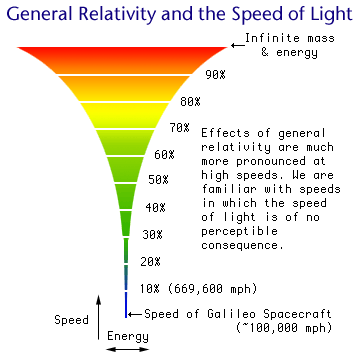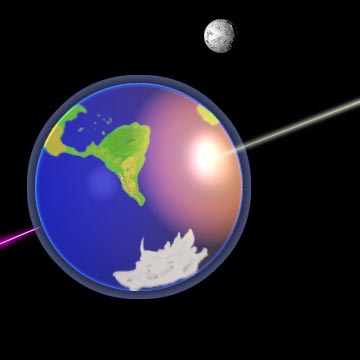If you are a Trekkie (excuse me, Trekker), and even if you are merely familiar with the general theory of relativity, you have probably fantasized about faster-than-light travel. The following is a look at the wacky things made possible in the world of Star Trek with warp propulsion.
 But alas, before
I get to the juicy part, I must provide you all with a short science lesson.
For those of you familiar with the theory of general relativity, you can
skip my skillful synopsis of light-speed travel, at the
expense of my feelings. First of all, it is important to understand that
the speed of light is, as far as we can determine, nature's ultimate speed
limit. It would take an infinite amount of energy to accelerate an object
to the speed of light. Think of it as an upside down pyramid. At first,
moving at a minuscule fraction of the speed of light requires just a bit
of energy. As speed increases, so does the amount of energy. But at significant
portions of the speed of light, the energy required increases exponentially.
For instance, to accelerate from 90% to 95% of the speed of light requires
the energy expenditure to be doubled. To increase speed from 95% to 97.5%
requires that energy to double. The difference between any speed lower
than the speed of light and the speed of light can be halved, thus it requires
an infinite amount of energy to accelerate to the speed of light. On the
other hand, it is perfectly possible to move at 99.999% of the speed of
light (just very, very hard).
But alas, before
I get to the juicy part, I must provide you all with a short science lesson.
For those of you familiar with the theory of general relativity, you can
skip my skillful synopsis of light-speed travel, at the
expense of my feelings. First of all, it is important to understand that
the speed of light is, as far as we can determine, nature's ultimate speed
limit. It would take an infinite amount of energy to accelerate an object
to the speed of light. Think of it as an upside down pyramid. At first,
moving at a minuscule fraction of the speed of light requires just a bit
of energy. As speed increases, so does the amount of energy. But at significant
portions of the speed of light, the energy required increases exponentially.
For instance, to accelerate from 90% to 95% of the speed of light requires
the energy expenditure to be doubled. To increase speed from 95% to 97.5%
requires that energy to double. The difference between any speed lower
than the speed of light and the speed of light can be halved, thus it requires
an infinite amount of energy to accelerate to the speed of light. On the
other hand, it is perfectly possible to move at 99.999% of the speed of
light (just very, very hard).
As objects increase in speed, they increase in mass. Although these effects are not perceptible at speeds we are familiar with, they are detectable at significant portions of the speed of light. An object reaches infinite mass when it moves at the speed of light, thereby giving it infinite inertia and making it impossible to accelerate. Effects leading up to this are observable and have been demonstrated.
Now that we know that it takes an infinite amount of energy to accelerate any object to the speed of light, and that the object's mass increases to infinity, let us apply Star Trek technology. If a warp core can accelerate a starship to several times the speed of light in a rather casual way, a basic variant of this technology would allow us to hook a ping pong ball dispenser up to an engine designed to launch objects at warp speed. The resultant combination would be the ultimate weapon of armageddon, The Warp Gauss Cannon.
Let us imagine what would happen if a guy in a spaceship somewhere decided to fire a ping pong ball at an inhabited Earthlike planet. He would have the tactical advantage. He could park his spaceship millions of miles away from his target, hidden in the depths of space, mobile and unknown (unlike the target home planet).
A ping pong ball traveling at any speed over the speed of light would stike the outer atmosphere of our target planet with so much force that anyone on the planet would be instantly turned into scrambled paste by the shockwave. With the population gone, we can skip the grisly details of charred flesh and boiling oceanic creatures and go back to the effects of the overall impact.
 The atmosphere
would shatter like a cubic yard of ice being smashed by a hypersonic cannonball,
but before it traveled any distance it would burst into flames at many
thousands of degrees fahrenheit (or celsius or Kelvin, pick your favorite).
The atmosphere
would shatter like a cubic yard of ice being smashed by a hypersonic cannonball,
but before it traveled any distance it would burst into flames at many
thousands of degrees fahrenheit (or celsius or Kelvin, pick your favorite).
The ping pong ball would pass through the atmosphere and the rest of the planet without noticing, as it is infinitely massive. The actual surface of the planet, upon being struck, would invariably melt as the shockwave aggravated the molecules of the soil and rock superheats soil, rock, and the iron of the planet core. The oceans would rapidly boil. Nuclear reactions near points of impact would cause a tube of nuclear explosions at all points where the ping pong ball passes through the planet. The force of these explosions and the shockwave of impact combined would cause the planet to explode at a significant portion of the speed of light, destroying any spaceships or space stations and habitats in the planet's vicinity. The light of the exploding planet would at least be comparable to the light of a neutron star.
In conclusion, the whole of the Star Trek world would be blown to bits by the merest introduction of warp propulsion. On the other hand, it would be not be the same without it. Paradox? Heavens no, more of a design flaw.
Thanks to Jay for coming up with this theory.